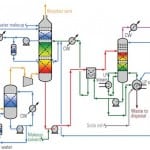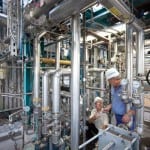A year-long 1-MW pilot test demonstrating postcombustion carbon capture technology for coal-fired power plants has reportedly captured more than 90% of carbon dioxide from a slipstream of flue gas at FirstEnergy Corp.’s R.E. Burger Plant near Shadyside, Ohio.
Powerspan said on Tuesday that the pilot performance data for its ECO2 pilot unit “provides all of the information needed for Powerspan to confidently move to commercial scale demonstration systems.” Commercial cost estimates based on pilot performance data are less than $50 per ton for CO2 capture and compression.
The postcombustion capture process uses an ammonia-based (not amine) solution to capture CO2 from flue gas after the nitrogen oxide (NOX), sulfur dioxide (SO2), oxidized mercury and fine particulate matter is captured using ECO, ECO-SO2 technology or other air pollution control system. Once the CO2 is absorbed, the solution containing CO2 is regenerated through heating to release the captured carbon dioxide. Ammonia and water vapor are also released during regeneration, though these are recovered and returned to the absorbing solution.
The product CO2 is then in a form that is ready for compression, pipeline transport and sequestration. According to Powerspan’s website, ECO2 process does not consume ammonia and no separate by-product is created by an ECO2 system.
"Our goal with the ECO2 pilot unit has been to demonstrate performance that results in lower energy costs than other post-combustion CO2 capture technologies," said senior vice president of engineering and R&D Christopher R. McLarnon, Ph.D. "The pilot performance data we have gathered shows that we have achieved this goal, and we are continuing to optimize the system.
According to the Powerspan, during extended runs, the pilot unit reportedly averaged greater than 90% CO2 capture at design inlet CO2 conditions with regeneration energy of less than 1,200 btu/lb after heat integration. The product CO2 was purified to meet industrial pipeline specifications using equipment that is part of the pilot installation. “The pilot unit has demonstrated that it can adapt to the normal changes of an operating power plant, which is a necessary step in moving toward commercial scale systems,” the company said.
Powerspan plans to publish an independent review of pilot test results in early 2010 along with an independent assessment of commercial cost implications.
The technology has been under development since 2004 in conjunction with the U.S. Energy Department’s National Energy Technology Laboratory (NETL) under a cooperative research and development agreement. In December 2007, Powerspan announced it exclusively licensed a patent for the process from NETL.
Commissioning of the ECO2 pilot unit at the Burger plant was completed in December 2008. During 2009, Powerspan made enhancements to the pilot configuration, and this resulted in “improved performance at lower energy cost,” the company said. Powerspan is continuing to optimize the pilot system at the Burger plant. The ECO2 pilot unit is jointly funded by Powerspan and FirstEnergy.
Powerspan’s ECO2 technology is a post-combustion CO2 capture process designed to capture 90 percent of CO2 from the flue gas of coal-fired power plants. Once the CO2 is captured, it is dried and compressed and is ready for pipeline transport and sequestration.
Source: Powerspan Corp.









